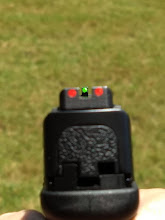I received this on Tuesday in response to my message to Senator Inhofe advising him that in the event Senator Feinkenstein's updated so-called Assault Weapons Ban passes Congress and is signed by the President that "I shall not comply."
Dear Mr. Smith:
Thank you for contacting me about the Second Amendment. As your voice in Washington, I appreciate knowing your views.
In 1994, the assault weapons ban established a comprehensive regulatory scheme of prohibiting the manufacture, transfer, or possession of assault weapons, as well as the possession or transfer of large capacity ammunition feeding devices that hold more than 10 rounds. These magazines are used by millions of Americans and are customary in handguns and other firearms. Nineteen specific weapons and their copycats were banned by the original legislation signed into law by President Clinton on September 13, 1994. The weapons ban was contained in a larger Violent Crime Control and Law Enforcement Act of 1994, and expired on September 13, 2004. As a member of the House of Representatives in 1994, I voted against the Violent Crime Control and Law Enforcement Act of 1994 because of the undue restrictions on weapons, among other reasons.
Semi-automatic assault weapons function similarly to other semi-automatic firearms, as they fire one round per pull of the trigger. It is important to note that under the assault weapons ban, the defining features of a semi-automatic assault weapon are mostly cosmetic. For example, a handgun is classified as a semi-automatic assault weapon if its magazine is visible, despite the fact that it fires one bullet per pull of the trigger and the speed of fire remains the same. Therefore, the law banned certain guns that are functionally identical to other weapons that are still considered to be legal.
While supporters of the ban may point out that the violent crime rate dropped after the 1994 ban, they do not mention that violent crime was dropping before the ban was instituted in 1994 and that gun ownership, including ownership of newer designs of the banned weapons, rose during that same time period. It is also important to note that these weapons were rarely used in the commission of crimes before the 1994 ban.
Additionally, a provision of the 1994 law required a study of the effectiveness of the weapons ban. The Congressional study showed that, according to police reports and federal felon surveys, the type of weapons banned in 1994 were only used in one to two percent of violent crimes. Murders committed by knives, clubs, and bare hands outnumbered murders by weapons 20 to one. According to a recent study, existing data does not show whether the number of people shot and killed with semi-automatic assault weapons declined during the 10-year period (1994-2004).
Should any attempt be made to reinstate the semi-automatic assault weapons ban, I will strongly oppose it. Law-abiding gun owners should be free to use their firearms for hunting, marksmanship, and self-defense. The statistics demonstrate that a true ban on these weapons will not significantly decrease crime but will significantly decrease our rights guaranteed by the Constitution. When I was sworn in as a member of Congress, I took an oath to uphold and defend the Constitution. As your representative in the Senate, I will continue to staunchly oppose any attempt to tamper with our nation's Constitution or undermine our Second Amendment rights.
Sincerely,
James M. Inhofe
United States Senator
Thank you, Senator Inhofe, for your support of our constitutionally-guaranteed right to keep and bear arms.
ECS
No Homicide Yet?
2 hours ago

No comments:
Post a Comment
Trolls need not apply. Watch your language.